常见表达逻辑关系的副词及连词
现代汉语连词
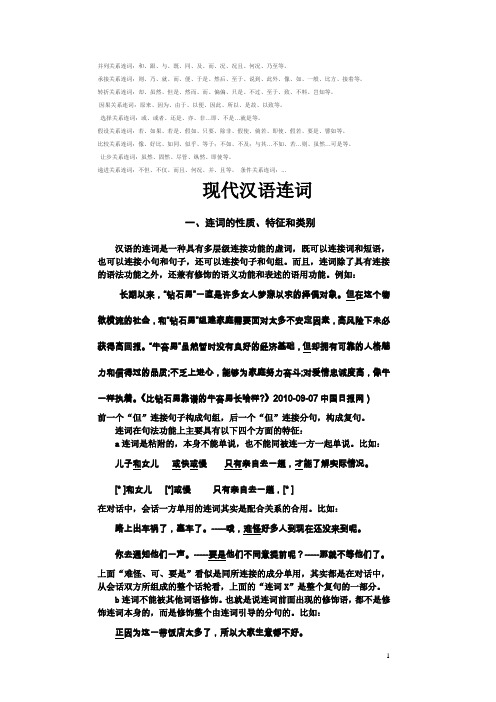
并列关系连词:和、跟、与、既、同、及、而、况、况且、何况、乃至等。
承接关系连词:则、乃、就、而、便、于是、然后、至于、说到、此外、像、如、一般、比方、接着等。
转折关系连词:却、虽然、但是、然而、而、偏偏、只是、不过、至于、致、不料、岂知等。
因果关系连词:原来、因为、由于、以便、因此、所以、是故、以致等。
选择关系连词:或、或者、还是、亦、非…即、不是…就是等。
假设关系连词:若、如果、若是、假如、只要、除非、假使、倘若、即使、假若、要是、譬如等。
比较关系连词:像、好比、如同、似乎、等于;不如、不及;与其…不如、若…则、虽然…可是等。
让步关系连词:虽然、固然、尽管、纵然、即使等。
递进关系连词:不但、不仅、而且、何况、并、且等。
条件关系连词:...现代汉语连词一、连词的性质、特征和类别汉语的连词是一种具有多层级连接功能的虚词,既可以连接词和短语,也可以连接小句和句子,还可以连接句子和句组。
而且,连词除了具有连接的语法功能之外,还兼有修饰的语义功能和表述的语用功能。
例如:长期以来,“钻石男”一直是许多女人梦寐以求的择偶对象。
但在这个物欲横流的社会,和“钻石男”组建家庭需要面对太多不安定因素,高风险下未必获得高回报。
“牛奋男”虽然暂时没有良好的经济基础,但却拥有可靠的人格魅力和信得过的品质;不乏上进心,能够为家庭努力奋斗;对爱情忠诚度高,像牛一样执着。
《比钻石男靠谱的牛奋男长啥样?》2010-09-07中国日报网)前一个“但”连接句子构成句组,后一个“但”连接分句,构成复句。
连词在句法功能上主要具有以下四个方面的特征:a连词是粘附的,本身不能单说,也不能同被连一方一起单说。
比如:儿子和女儿或快或慢只有亲自去一趟,才能了解实际情况。
[* ]和女儿[*]或慢只有亲自去一趟,[* ]在对话中,会话一方单用的连词其实是配合关系的合用。
比如:路上出车祸了,塞车了。
-----哦,难怪好多人到现在还没来到呢。
你去通知他们一声。
什么是连词

什么是连词?连词(Conjunctions)是英语中的一类词类,用于连接词语、短语、从句或句子,以形成更复杂的句子结构。
连词在句子中起到连接作用,用于表达并列、选择、因果、条件、对比、目的、让步等关系。
以下是一些常见的连词及其用法:1. 并列连词(Coordinating Conjunctions):用于连接并列的词语、短语或句子。
常见的并列连词有:and(和)、but(但是)、or(或者)、so(所以)、for(因为)、nor(也不)、yet(然而)等。
- I like coffee and tea.(我喜欢咖啡和茶。
)- She is smart but lazy.(她聪明但懒惰。
)- You can have cake or ice cream.(你可以吃蛋糕或冰淇淋。
)2. 从属连词(Subordinating Conjunctions):用于连接主句和从句,从属连词引导的从句依赖于主句,表示因果、条件、时间、让步、目的等关系。
常见的从属连词有:because(因为)、although(虽然)、if(如果)、when(当)、while(当……的时候)、so that(以便)、in order that (为了)、unless(除非)等。
- I can't go out because it's raining.(因为下雨,我不能出去。
)- Although she is tired, she keeps working.(虽然她累了,她还在工作。
)- If you study hard, you will pass the exam.(如果你努力学习,你会通过考试。
)3. 连接副词(Correlative Conjunctions):由两个连词组成的连词对,用于连接词语、短语或句子,表达对比、选择、并列等关系。
常见的连接副词有:either...or(要么……要么)、neither...nor (既不……也不)、both...and(既……又)、not only...but also(不仅……而且)等。
汉语中副介连词
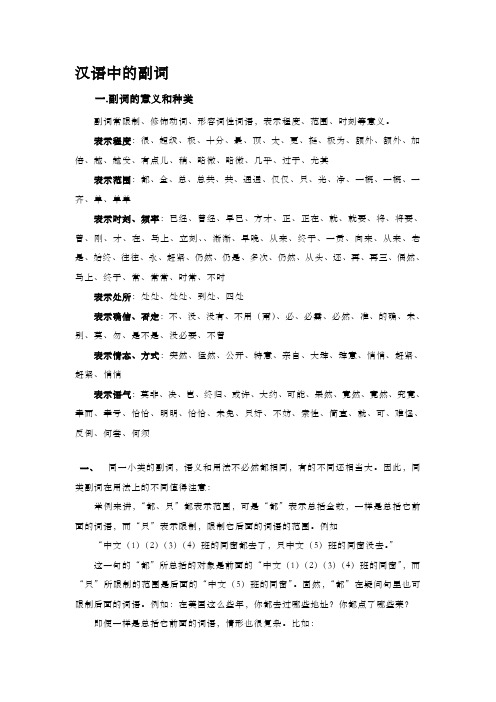
汉语中的副词一.副词的意义和种类副词常限制、修饰动词、形容词性词语,表示程度、范围、时刻等意义。
表示程度:很、超级、极、十分、最、顶、太、更、挺、极为、额外、额外、加倍、越、越发、有点儿、稍、略微、略微、几乎、过于、尤其表示范围:都、全、总、总共、共、通通、仅仅、只、光、净、一概、一概、一齐、单、单单表示时刻、频率:已经、曾经、早已、方才、正、正在、就、就要、将、将要、曾、刚、才、在、马上、立刻、、渐渐、早晚、从来、终于、一贯、向来、从来、老是、始终、往往、永、赶紧、仍然、仍是、多次、仍然、从头、还、再、再三、偶然、马上、终于、常、常常、时常、不时表示处所:处处、处处、到处、四处表示确信、否定:不、没、没有、不用(甭)、必、必需、必然、准、的确、未、别、莫、勿、是不是、没必要、不曾表示情态、方式:突然、猛然、公开、特意、亲自、大肆、肆意、悄悄、赶紧、赶紧、悄悄表示语气:莫非、决、岂、终归、或许、大约、可能、果然、竟然、竟然、究竟、幸而、幸亏、恰恰、明明、恰恰、未免、只好、不妨、索性、简直、就、可、难怪、反倒、何尝、何须一、同一小类的副词,语义和用法不必然都相同,有的不同还相当大。
因此,同类副词在用法上的不同值得注意:举例来讲,“都、只”都表示范围,可是“都”表示总括全数,一样是总括它前面的词语,而“只”表示限制,限制它后面的词语的范围。
例如“中文(1)(2)(3)(4)班的同窗都去了,只中文(5)班的同窗没去。
”这一句的“都”所总括的对象是前面的“中文(1)(2)(3)(4)班的同窗”,而“只”所限制的范围是后面的“中文(5)班的同窗”。
固然,“都”在疑问句里也可限制后面的词语。
例如:在美国这么些年,你都去过哪些地址?你都点了哪些莱?即便一样是总括它前面的词语,情形也很复杂。
比如:这些书我都看过了。
(“都”总括它前面的“这些书”)这本书咱们都看过了。
(“都”总括它前面的“咱们”)这些书咱们都看过了。
SAT逻辑连接词

8.目的(purpose)
to these end/to this end(为实现以上目的..)真题考过两次
9.确定性(Certainty)
certainly
plainly显然地
of
undoubtedly毫无疑问地
10.时间和空间(Time and space)
until、meanwhile、when/whenever/while、at present/at the moment、as soon as
afterward, after, first, later, then, soon, outside, near, beyond, above, below, on the right(left), in the middle, opposite, in front of
☆☆whereas, in contrast, on the other hand另一方面,alternatively 或(另外一个选择/解决方案)
☆☆otherwise否则、不然的话(句中出现,一般不会单独考)
☆nevertheless/nonetheless(尽管如此)经常出现,从来不选!
3.比较(Comparison)
SAT逻辑连接词—关系副词类
1.递进(Addition)
☆☆furthermore, besides, moreover, in addition/additionally, what`s more此外,而且
☆again, also, next, finally,
also/as well as/as well也----一般不考,出现也不选
连词的知识点总结
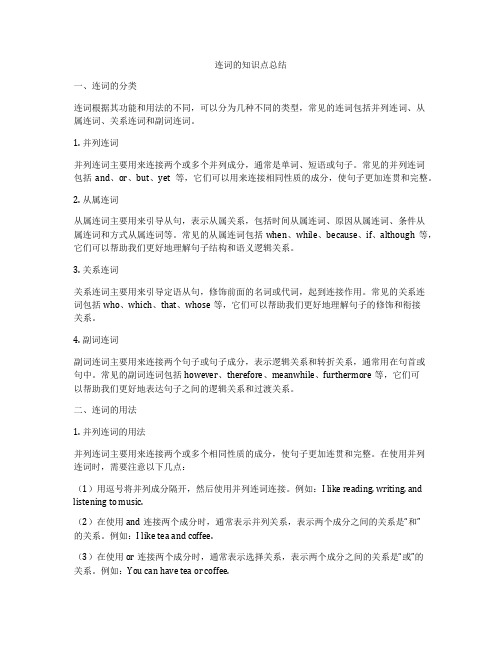
连词的知识点总结一、连词的分类连词根据其功能和用法的不同,可以分为几种不同的类型,常见的连词包括并列连词、从属连词、关系连词和副词连词。
1. 并列连词并列连词主要用来连接两个或多个并列成分,通常是单词、短语或句子。
常见的并列连词包括and、or、but、yet等,它们可以用来连接相同性质的成分,使句子更加连贯和完整。
2. 从属连词从属连词主要用来引导从句,表示从属关系,包括时间从属连词、原因从属连词、条件从属连词和方式从属连词等。
常见的从属连词包括when、while、because、if、although等,它们可以帮助我们更好地理解句子结构和语义逻辑关系。
3. 关系连词关系连词主要用来引导定语从句,修饰前面的名词或代词,起到连接作用。
常见的关系连词包括who、which、that、whose等,它们可以帮助我们更好地理解句子的修饰和衔接关系。
4. 副词连词副词连词主要用来连接两个句子或句子成分,表示逻辑关系和转折关系,通常用在句首或句中。
常见的副词连词包括however、therefore、meanwhile、furthermore等,它们可以帮助我们更好地表达句子之间的逻辑关系和过渡关系。
二、连词的用法1. 并列连词的用法并列连词主要用来连接两个或多个相同性质的成分,使句子更加连贯和完整。
在使用并列连词时,需要注意以下几点:(1)用逗号将并列成分隔开,然后使用并列连词连接。
例如:I like reading, writing, and listening to music.(2)在使用and连接两个成分时,通常表示并列关系,表示两个成分之间的关系是“和”的关系。
例如:I like tea and coffee.(3)在使用or连接两个成分时,通常表示选择关系,表示两个成分之间的关系是“或”的关系。
例如:You can have tea or coffee.(4)在使用but连接两个成分时,通常表示转折关系,表示两个成分之间的关系是“但是”的关系。
连词知识点总结15条
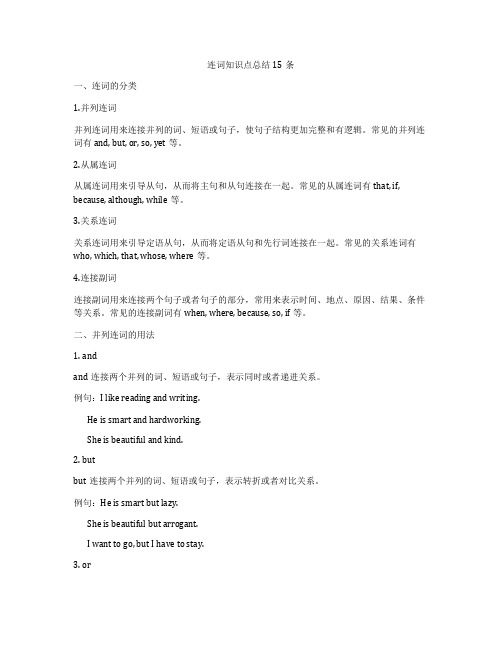
连词知识点总结15条一、连词的分类1.并列连词并列连词用来连接并列的词、短语或句子,使句子结构更加完整和有逻辑。
常见的并列连词有and, but, or, so, yet等。
2.从属连词从属连词用来引导从句,从而将主句和从句连接在一起。
常见的从属连词有that, if, because, although, while等。
3.关系连词关系连词用来引导定语从句,从而将定语从句和先行词连接在一起。
常见的关系连词有who, which, that, whose, where等。
4.连接副词连接副词用来连接两个句子或者句子的部分,常用来表示时间、地点、原因、结果、条件等关系。
常见的连接副词有when, where, because, so, if等。
二、并列连词的用法1. andand连接两个并列的词、短语或句子,表示同时或者递进关系。
例句:I like reading and writing.He is smart and hardworking.She is beautiful and kind.2. butbut连接两个并列的词、短语或句子,表示转折或者对比关系。
例句:He is smart but lazy.She is beautiful but arrogant.I want to go, but I have to stay.3. oror连接两个并列的词、短语或句子,表示选择或者替代关系。
例句:Do you want tea or coffee?You can go by bus or by train.Is it spring or autumn here?4. soso连接两个并列的句子,表示因果关系或者推理结果。
例句:The weather is good, so we can go for a picnic.I studied hard, so I passed the exam.She was tired, so she went to bed early.5. yetyet连接两个并列的句子,表示转折关系或者限制条件。
考研英语中常见的逻辑关系词
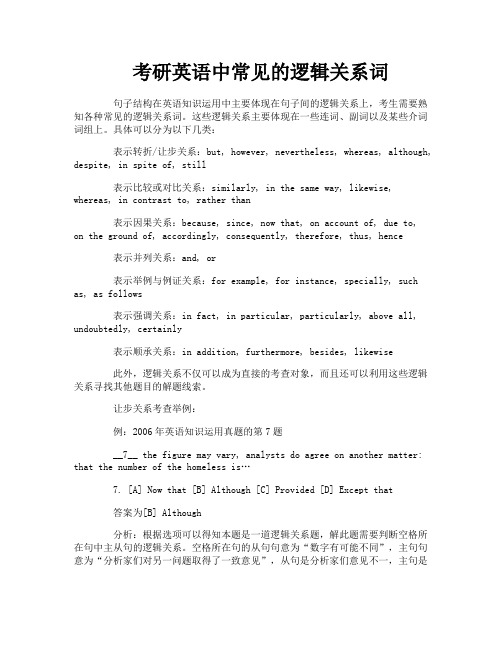
考研英语中常见的逻辑关系词句子结构在英语知识运用中主要体现在句子间的逻辑关系上,考生需要熟知各种常见的逻辑关系词。
这些逻辑关系主要体现在一些连词、副词以及某些介词词组上。
具体可以分为以下几类:表示转折/让步关系:but, however, nevertheless, whereas, although, despite, in spite of, still表示比较或对比关系:similarly, in the same way, likewise, whereas, in contrast to, rather than表示因果关系:because, since, now that, on account of, due to,on the ground of, accordingly, consequently, therefore, thus, hence 表示并列关系:and, or表示举例与例证关系:for example, for instance, specially, such as, as follows表示强调关系:in fact, in particular, particularly, above all, undoubtedly, certainly表示顺承关系:in addition, furthermore, besides, likewise此外,逻辑关系不仅可以成为直接的考查对象,而且还可以利用这些逻辑关系寻找其他题目的解题线索。
让步关系考查举例:例:2006年英语知识运用真题的第7题__7__ the figure may vary, analysts do agree on another matter: that the number of the homeless is…7. [A] Now that [B] Although [C] Provided [D] Except that答案为[B] Although分析:根据选项可以得知本题是一道逻辑关系题,解此题需要判断空格所在句中主从句的逻辑关系。
考研英语需掌握的7类逻辑关系词
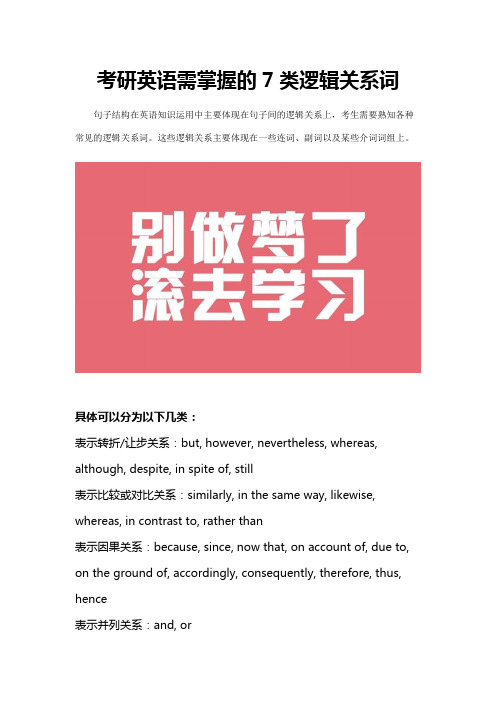
考研英语需掌握的7类逻辑关系词句子结构在英语知识运用中主要体现在句子间的逻辑关系上,考生需要熟知各种常见的逻辑关系词。
这些逻辑关系主要体现在一些连词、副词以及某些介词词组上。
具体可以分为以下几类:表示转折/让步关系:but, however, nevertheless, whereas, although, despite, in spite of, still表示比较或对比关系:similarly, in the same way, likewise, whereas, in contrast to, rather than表示因果关系:because, since, now that, on account of, due to, on the ground of, accordingly, consequently, therefore, thus, hence表示并列关系:and, or表示举例与例证关系:for example, for instance, specially, such as, as follows表示强调关系:in fact, in particular, particularly, above all, undoubtedly, certainly表示顺承关系:in addition, furthermore, besides, likewise此外,逻辑关系不仅可以成为直接的考查对象,而且还可以利用这些逻辑关系寻找其他题目的解题线索。
让步关系考查举例:例:2006年英语知识运用真题的第7题__7__ the figure may vary, analysts do agree on another matter: that the number of the homeless is…[A] Now that [B] Although [C] Provided [D] Except that答案为[B] Although分析:根据选项可以得知本题是一道逻辑关系题,解此题需要判断空格所在句中主从句的逻辑关系。
连词的分类及用法详解
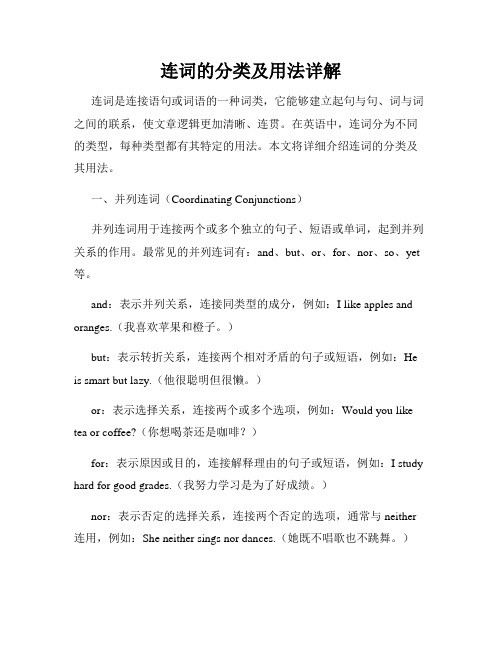
连词的分类及用法详解连词是连接语句或词语的一种词类,它能够建立起句与句、词与词之间的联系,使文章逻辑更加清晰、连贯。
在英语中,连词分为不同的类型,每种类型都有其特定的用法。
本文将详细介绍连词的分类及其用法。
一、并列连词(Coordinating Conjunctions)并列连词用于连接两个或多个独立的句子、短语或单词,起到并列关系的作用。
最常见的并列连词有:and、but、or、for、nor、so、yet 等。
and:表示并列关系,连接同类型的成分,例如:I like apples and oranges.(我喜欢苹果和橙子。
)but:表示转折关系,连接两个相对矛盾的句子或短语,例如:He is smart but lazy.(他很聪明但很懒。
)or:表示选择关系,连接两个或多个选项,例如:Would you like tea or coffee?(你想喝茶还是咖啡?)for:表示原因或目的,连接解释理由的句子或短语,例如:I study hard for good grades.(我努力学习是为了好成绩。
)nor:表示否定的选择关系,连接两个否定的选项,通常与neither 连用,例如:She neither sings nor dances.(她既不唱歌也不跳舞。
)so:表示结果或原因,连接因果关系的句子或短语,例如:He studied hard, so he passed the exam.(他努力学习,所以考试及格了。
)yet:表示转折关系,常用于否定句中,表示与预期相反的情况,例如:She is tired, yet she keeps working.(她很累,但她还在工作。
)二、从属连词(Subordinating Conjunctions)从属连词用于引导一个从句与主句之间的关系,从属连词将一个不完整的句子变成了一个从属句。
常见的从属连词有:after、although、because、before、if、since、unless、when、while等。
副词介词连词
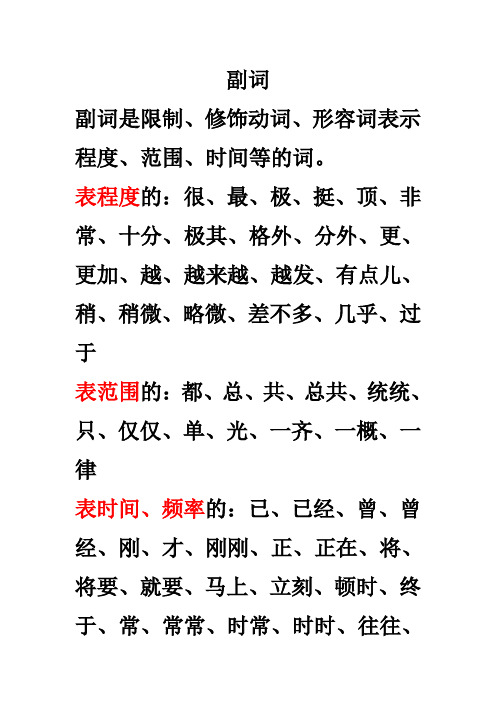
副词副词是限制、修饰动词、形容词表示程度、范围、时间等的词。
表程度的:很、最、极、挺、顶、非常、十分、极其、格外、分外、更、更加、越、越来越、越发、有点儿、稍、稍微、略微、差不多、几乎、过于表范围的:都、总、共、总共、统统、只、仅仅、单、光、一齐、一概、一律表时间、频率的:已、已经、曾、曾经、刚、才、刚刚、正、正在、将、将要、就要、马上、立刻、顿时、终于、常、常常、时常、时时、往往、渐渐、一直、一向、向来、从来、总是、始终,永、永远、赶紧表肯定否定的:必、必须、必定、必然、当然、准、的确、不、没有、没、未、别、莫、勿、未必、不必、何必、不便、不用(甭)、不妨表语气的:难道、岂、究竟、到底、偏偏、索性、简直、是、是否、可、也许、难怪、大约、幸而、幸亏、反倒、反正、果然、居然、何尝、其实、明明、恰恰、未免、只好介词一般用在名词,代词或名词性质的短语前面,和这些词合起来组成介词结构,以表示所处、时间、状态、方式、原因、目的、比较对象等的词。
介词的分类编辑(1)表示时间、处所:从自自从于打到往在当朝向顺着沿着随着(2)表示方式:按照按照依依照本着经过通过根据以凭(3)表示目的:为为了为着(4)表示原因:因由于因为只有(5)表示对象、范围:对对于把向跟与同给关于(6)表示排除:除除了除去除非(7)表示被动:被叫让给使才(8)表示比较:比和与同连词连词是用来连接词与词、词组与词组或句子与句子、表示某种逻辑关系的虚词。
连词可以表并列、承接、转折、因果、选择、假设、比较、让步等关系。
并列关系连词:和、跟、与、既、同、及、而、况、况且、何况、乃至等。
承接关系连词:则、乃、就、而、便、于是、然后、至于、说到、此外、像、如、一般、比方、接着等。
转折关系连词:却、虽然、但是、然而、而、偏偏、只是、不过、至于、致、不料、岂知等。
因果关系连词:原来、因为、由于、以便、因此、所以、是故、以致等。
选择关系连词:或、或者、还是、亦、非…即、不是…就是等。
(完整版)汉语中的副、介、连词

汉语中的副词一.副词的意义和种类副词常限制、修饰动词、形容词性词语,表示程度、范围、时间等意义。
表示程度:很、非常、极、十分、最、顶、太、更、挺、极其、格外、分外、更加、越、越发、有点儿、稍、稍微、略微、几乎、过于、尤其表示范围:都、全、总、总共、共、统统、仅仅、只、光、净、一概、一律、一齐、单、单单表示时间、频率:已经、曾经、早已、刚刚、正、正在、就、就要、将、将要、曾、刚、才、在、马上、立刻、、渐渐、早晚、从来、终于、一向、向来、从来、总是、始终、往往、永、赶紧、仍然、还是、屡次、依然、重新、还、再、再三、偶尔、顿时、终于、常、常常、时常、时时表示处所:到处、处处、随处、四处表示肯定、否定:不、没、没有、不用(甭)、必、必须、必定、准、的确、未、别、莫、勿、是否、不必、不曾表示情态、方式:忽然、猛然、公然、特意、亲自、大肆、肆意、悄悄、连忙、赶紧、暗暗表示语气:难道、决、岂、反正、也许、大约、大概、果然、居然、竟然、究竟、幸而、幸亏、偏偏、明明、恰恰、未免、只好、不妨、索性、简直、就、可、难怪、反倒、何尝、何必1、同一小类的副词,语义和用法不一定都相同,有的差别还相当大。
所以,同类副词在用法上的差别值得注意:举例来说,“都、只”都表示范围,但是“都”表示总括全部,一般是总括它前面的词语,而“只"表示限制,限制它后面的词语的范围。
例如“中文(1)(2)(3)(4)班的同学都去了,只中文(5)班的同学没去。
”这一句的“都”所总括的对象是前面的“中文(1)(2)(3)(4)班的同学”,而“只”所限制的范围是后面的“中文(5)班的同学”。
当然,“都”在疑问句里也可限制后面的词语。
例如:在美国这么些年,你都去过哪些地方?你都点了哪些莱?即使同样是总括它前面的词语,情况也很复杂.比如:这些书我都看过了.(“都”总括它前面的“这些书")这本书我们都看过了。
(“都"总括它前面的“我们")这些书我们都看过了。
连接副词知识点总结

连接副词的分类连接副词的种类多种多样,按照其不同的功能可以大致分为以下几类:1. 表示因果关系的连接副词,如:therefore, hence, thus, so等。
这类连接副词用于表达一个事件或现象的原因和结果之间的逻辑关系。
2. 表示对比关系的连接副词,如:however, nevertheless, on the contrary, in contrast等。
这类连接副词用于表达两个事物或观点之间的对比和差异。
3. 表示时间顺序的连接副词,如:meanwhile, meanwhile, then, afterwards等。
这类连接副词用于连接句子或短语,表示事件或动作发生的时间顺序。
4. 表示条件关系的连接副词,如:if, unless, whether, provided等。
这类连接副词用于引导条件状语从句,表示某件事情的发生条件。
5. 表示目的或结果的连接副词,如:thus, hence, therefore, accordingly等。
这类连接副词用于表达某个行为或事件的目的或结果。
6. 表示让步关系的连接副词,如:although, though, even though, whereas等。
这类连接副词用于表示对已知情况的转折或对比。
连接副词的使用方法连接副词的使用方法相对比较灵活,但是需要按照正确的语境和语法规则来进行搭配和使用,下面是一些连接副词的使用方法:1. 连接副词通常位于句首或者句中,用于连接前后两个句子或短语。
例如:However, I still believe that it is possible to achieve our goal.(然而,我仍然相信我们能够实现我们的目标。
)2. 连接副词在句子中的位置可以根据需要来调整,但需要注意句子结构的平衡和逻辑性。
例如:The weather was bad; nevertheless, we decided to go out for a walk. (天气很糟糕,然而,我们还是决定出去散步。
常见表达逻辑关系的副词及连词
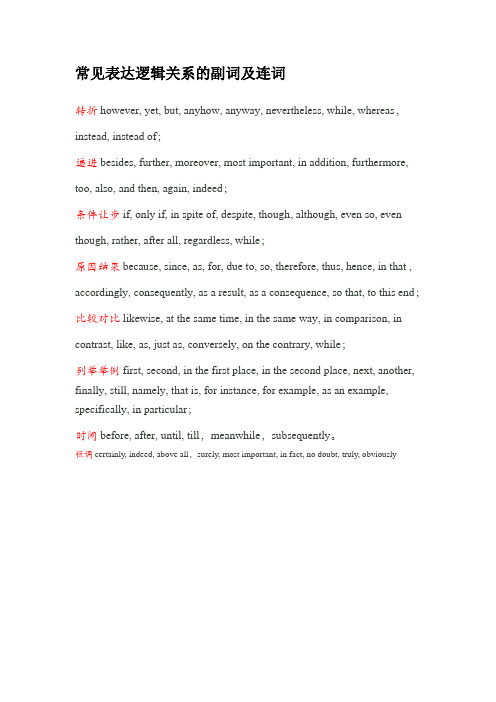
常见表达逻辑关系的副词及连词转折however, yet, but, anyhow, anyway, nevertheless, while, whereas,instead, instead of;递进besides, further, moreover, most important, in addition, furthermore, too, also, and then, again, indeed;条件让步if, only if, in spite of, despite, though, although, even so, even though, rather, after all, regardless, while;原因结果because, since, as, for, due to, so, therefore, thus, hence, in that , accordingly, consequently, as a result, as a consequence, so that, to this end;比较对比likewise, at the same time, in the same way, in comparison, in contrast, like, as, just as, conversely, on the contrary, while;列举举例first, second, in the first place, in the second place, next, another, finally, still, namely, that is, for instance, for example, as an example, specifically, in particular;时间before, after, until, till,meanwhile,subsequently。
英语连词的用法归纳 -回复
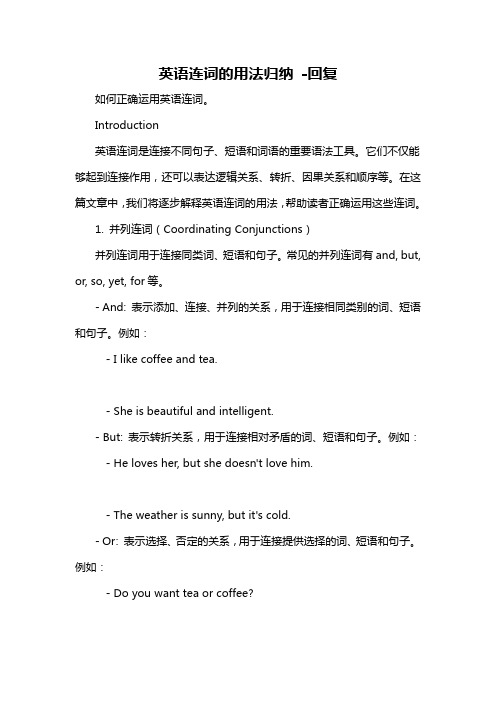
英语连词的用法归纳-回复如何正确运用英语连词。
Introduction英语连词是连接不同句子、短语和词语的重要语法工具。
它们不仅能够起到连接作用,还可以表达逻辑关系、转折、因果关系和顺序等。
在这篇文章中,我们将逐步解释英语连词的用法,帮助读者正确运用这些连词。
1. 并列连词(Coordinating Conjunctions)并列连词用于连接同类词、短语和句子。
常见的并列连词有and, but, or, so, yet, for等。
- And: 表示添加、连接、并列的关系,用于连接相同类别的词、短语和句子。
例如:- I like coffee and tea.- She is beautiful and intelligent.- But: 表示转折关系,用于连接相对矛盾的词、短语和句子。
例如:- He loves her, but she doesn't love him.- The weather is sunny, but it's cold.- Or: 表示选择、否定的关系,用于连接提供选择的词、短语和句子。
例如:- Do you want tea or coffee?- Should I wear a dress or pants?- So: 表示结果、因此的关系,用于连接因果关系的词、短语和句子。
例如:- I am tired, so I will go to bed early.- The traffic was heavy, so I arrived late.- Yet: 表示转折、然而的关系,用于连接对比、相反的词、短语和句子。
例如:- She is rich, yet she is not happy.- It's raining, yet I forgot to bring my umbrella.- For: 表示原因、目的的关系,用于连接解释原因的词、短语和句子。
汉语中的副、介、连词 (2)
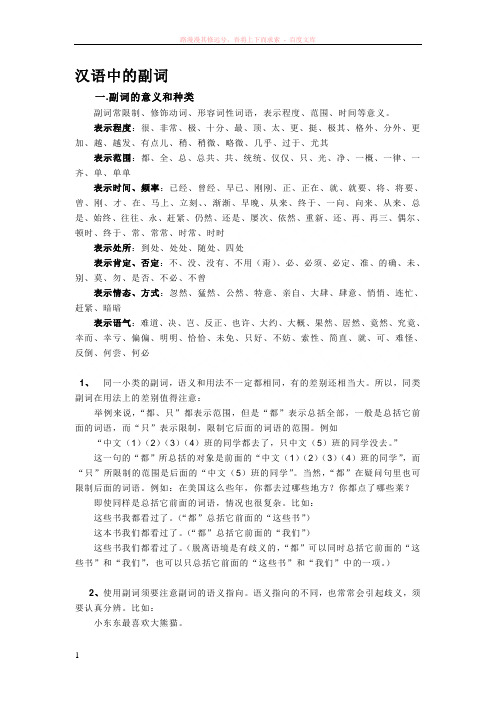
汉语中的副词一.副词的意义和种类副词常限制、修饰动词、形容词性词语,表示程度、范围、时间等意义。
表示程度:很、非常、极、十分、最、顶、太、更、挺、极其、格外、分外、更加、越、越发、有点儿、稍、稍微、略微、几乎、过于、尤其表示范围:都、全、总、总共、共、统统、仅仅、只、光、净、一概、一律、一齐、单、单单表示时间、频率:已经、曾经、早已、刚刚、正、正在、就、就要、将、将要、曾、刚、才、在、马上、立刻、、渐渐、早晚、从来、终于、一向、向来、从来、总是、始终、往往、永、赶紧、仍然、还是、屡次、依然、重新、还、再、再三、偶尔、顿时、终于、常、常常、时常、时时表示处所:到处、处处、随处、四处表示肯定、否定:不、没、没有、不用(甭)、必、必须、必定、准、的确、未、别、莫、勿、是否、不必、不曾表示情态、方式:忽然、猛然、公然、特意、亲自、大肆、肆意、悄悄、连忙、赶紧、暗暗表示语气:难道、决、岂、反正、也许、大约、大概、果然、居然、竟然、究竟、幸而、幸亏、偏偏、明明、恰恰、未免、只好、不妨、索性、简直、就、可、难怪、反倒、何尝、何必1、同一小类的副词,语义和用法不一定都相同,有的差别还相当大。
所以,同类副词在用法上的差别值得注意:举例来说,“都、只”都表示范围,但是“都”表示总括全部,一般是总括它前面的词语,而“只”表示限制,限制它后面的词语的范围。
例如“中文(1)(2)(3)(4)班的同学都去了,只中文(5)班的同学没去。
”这一句的“都”所总括的对象是前面的“中文(1)(2)(3)(4)班的同学”,而“只”所限制的范围是后面的“中文(5)班的同学”。
当然,“都”在疑问句里也可限制后面的词语。
例如:在美国这么些年,你都去过哪些地方?你都点了哪些莱?即使同样是总括它前面的词语,情况也很复杂。
比如:这些书我都看过了。
(“都”总括它前面的“这些书”)这本书我们都看过了。
(“都”总括它前面的“我们”)这些书我们都看过了。
如何正确使用选择副词和转折连词
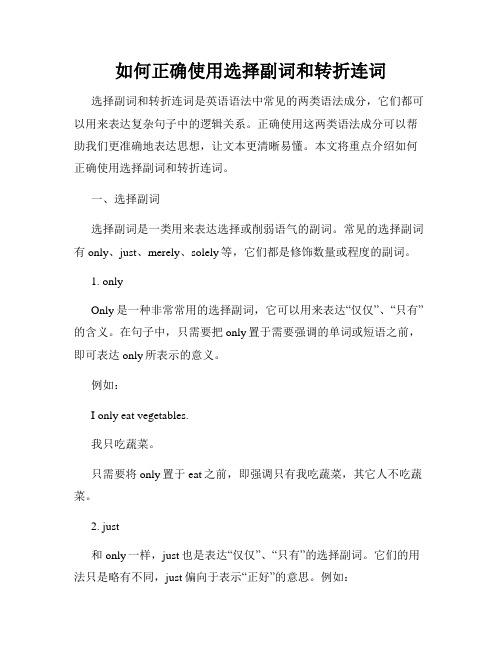
如何正确使用选择副词和转折连词选择副词和转折连词是英语语法中常见的两类语法成分,它们都可以用来表达复杂句子中的逻辑关系。
正确使用这两类语法成分可以帮助我们更准确地表达思想,让文本更清晰易懂。
本文将重点介绍如何正确使用选择副词和转折连词。
一、选择副词选择副词是一类用来表达选择或削弱语气的副词。
常见的选择副词有only、just、merely、solely等,它们都是修饰数量或程度的副词。
1. onlyOnly是一种非常常用的选择副词,它可以用来表达“仅仅”、“只有”的含义。
在句子中,只需要把only置于需要强调的单词或短语之前,即可表达only所表示的意义。
例如:I only eat vegetables.我只吃蔬菜。
只需要将only置于eat之前,即强调只有我吃蔬菜,其它人不吃蔬菜。
2. just和only一样,just也是表达“仅仅”、“只有”的选择副词。
它们的用法只是略有不同,just偏向于表示“正好”的意思。
例如:I just finished my homework.我刚完成了作业。
此处的just表达了正好完成作业的意思,而不是只是完成作业。
3. merelyMerely的含义和only和just都比较接近,意思是“仅仅”、“只不过”,但是它的含义更弱,语气更轻柔。
例如:He merely nodded his head.他只是点了点头。
只使用了merely,表达了他只是点头,弱化了这个动作的重要性。
选择副词可以在句中表达各种不同的语气和意思,但是需要注意使用时刻和使用位置。
二、转折连词转折连词表达一个句子和前面的句子之间的转折或否定关系,用来引出一个相反的观点,起到排比和对比的作用。
常见的转折连词有but、yet、however等。
1. butbut是最常见的转折连词,经常用于表达对比或转折关系。
但当引出正式的结论时,but则可以表示强调。
例如:I have studied English for years, but I still can't speak it fluently.我学习英语很多年了,但我仍然不能流利地说它。
句子之间的逻辑关系

句子之间的逻辑关系首先,递进关系是指句子之间表达的是一种逐渐加强的关系。
在句子之间建立递进关系时,我们通常会使用一些表示逐渐加强的连词或副词,比如“而且”、“不仅如此”等。
例如,“他不仅学习成绩优秀,而且还在课外活动中表现突出。
”在这个例子中,前一句和后一句之间通过“而且”这个递进的连词,表达了学习成绩和课外活动表现之间的逐渐加强的关系。
其次,转折关系是指句子之间表达的是一种相反或对比的关系。
在句子之间建立转折关系时,我们通常会使用一些表示对比的连词或副词,比如“但是”、“然而”等。
例如,“他原本计划去旅行,但是因为工作的原因最终取消了行程。
”在这个例子中,前一句和后一句之间通过“但是”这个转折的连词,表达了原本计划和最终取消之间的相反关系。
再次,因果关系是指句子之间表达的是一种原因和结果的关系。
在句子之间建立因果关系时,我们通常会使用一些表示原因和结果的连词或副词,比如“因为”、“所以”等。
例如,“因为下雨,所以比赛被取消了。
”在这个例子中,前一句和后一句之间通过“因为”和“所以”这两个表示因果关系的连词,表达了下雨和比赛取消之间的原因和结果关系。
最后,并列关系是指句子之间表达的是一种并列或平行的关系。
在句子之间建立并列关系时,我们通常会使用一些表示并列关系的连词或副词,比如“而且”、“同时”等。
例如,“他喜欢音乐,而且喜欢运动。
”在这个例子中,前一句和后一句之间通过“而且”这个并列的连词,表达了喜欢音乐和喜欢运动之间的并列关系。
总之,句子之间的逻辑关系对于文章的连贯性和逻辑性至关重要。
通过递进、转折、因果、并列等不同的逻辑关系,我们可以更好地表达自己的观点和想法,使文章更加连贯和有说服力。
希望本文的内容能够帮助大家更好地理解句子之间的逻辑关系,提高自己的写作水平。
汉语中的副介连词

汉语中的副词一.副词的意义和种类副词常限制、修饰动词、形容词性词语,表示程度、范围、时间等意义。
表示程度:很、超级、极、十分、最、顶、太、更、挺、极为、分外、额外、加倍、越、越发、有点儿、稍、略微、略微、几乎、过于、尤其表示范围:都、全、总、总共、共、通通、仅仅、只、光、净、一概、一概、一齐、单、单单表示时间、频率:已经、曾经、早已、方才、正、正在、就、就要、将、将要、曾、刚、才、在、马上、立刻、、渐渐、早晚、从来、终于、一贯、向来、从来、老是、始终、往往、永、赶紧、仍然、仍是、多次、仍然、从头、还、再、再三、偶尔、马上、终于、常、常常、时常、不时表示处所:处处、处处、处处、四处表示肯定、否定:不、没、没有、不用(甭)、必、必需、一定、准、的确、未、别、莫、勿、是不是、没必要、不曾表示情态、方式:突然、猛然、公开、特意、亲自、大肆、肆意、悄悄、赶紧、赶紧、悄悄表示语气:莫非、决、岂、终归、或许、大约、可能、果然、竟然、竟然、究竟、幸而、幸亏、恰恰、明明、恰恰、未免、只好、不妨、索性、简直、就、可、难怪、反倒、何尝、何须一、同一小类的副词,语义和用法不必然都相同,有的不同还相当大。
所以,同类副词在用法上的不同值得注意:举例来讲,“都、只”都表示范围,可是“都”表示总括全数,一般是总括它前面的词语,而“只”表示限制,限制它后面的词语的范围。
例如“中文(1)(2)(3)(4)班的同窗都去了,只中文(5)班的同窗没去。
”这一句的“都”所总括的对象是前面的“中文(1)(2)(3)(4)班的同窗”,而“只”所限制的范围是后面的“中文(5)班的同窗”。
固然,“都”在疑问句里也可限制后面的词语。
例如:在美国这么些年,你都去过哪些地方?你都点了哪些莱?即便一样是总括它前面的词语,情况也很复杂。
比如:这些书我都看过了。
(“都”总括它前面的“这些书”)这本书咱们都看过了。
(“都”总括它前面的“咱们”)这些书咱们都看过了。
